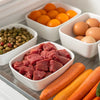Can You Cook Frozen Raw Dog Food? Understanding the Best Practices for Pet Nutrition
- Houndsy
Table of Contents
- Introduction
- Understanding Frozen Raw Dog Food
- Handling Frozen Raw Dog Food Safely
- Can You Cook Frozen Raw Dog Food?
- Best Practices for Serving Frozen Raw Dog Food
- After the Meal: Clean-Up and Storage
- Conclusion
Introduction
Did you know that some estimates suggest that nearly 70% of dog owners are considering raw food diets for their pets? Pet parents are increasingly recognizing the nutritional benefits of feeding their dogs a diet that mirrors their ancestral eating habits. However, with the rise of frozen raw dog food options, questions often arise about the best way to prepare these foods. One of the most pressing questions we often encounter is: Can you cook frozen raw dog food?
In this blog post, we will delve into the intricacies of feeding our furry friends frozen raw dog food—what it is, how it should be handled, and the safest methods for serving it to our pets without compromising their health. Our objective is to equip you with the knowledge to make informed choices about your dog’s diet and incorporate frozen raw foods safely into their routine.
We will cover topics including safe handling, thawing techniques, serving suggestions, as well as the reasons why cooking these foods might not be advisable. By the end of this post, you’ll not only gauge the potential benefits and drawbacks of raw dog food diets but also understand the best practices to ensure your pooch receives the nutrition they deserve while keeping their meals intact.
Understanding Frozen Raw Dog Food
What is Frozen Raw Dog Food?
Frozen raw dog food is an unprocessed diet comprised predominantly of uncooked meats, bones, fruits, and vegetables, all preserved through the freezing process. This feed option aims to replicate what dogs might consume in their natural habitats, providing a nutrient-rich and biologically appropriate diet.
- Nutritional Benefits: Undeniable benefits include higher retention of essential vitamins, minerals, and enzymes that are often diminished in heavily processed pet foods, ensuring a more nutrient-dense diet for our beloved dogs.
While the nutritional superiority of raw diets is widely acknowledged, it is essential for pet owners to understand how to handle and serve this food properly to maximize its benefits and mitigate any health risks associated with incorrect handling.
The Appeal of Frozen Raw Dog Food
Frozen raw dog food is not only appealing for its nutritional value; it also allows pet parents to have the reassurance of quality ingredients. Typically, these diets are free from preservatives, fillers, and artificial additives, catering to increasingly health-conscious dog owners who prefer all-natural or organic selections. Additionally, the convenience of frozen dog food simplifies the pet feeding process, allowing owners to store large quantities conveniently and only thaw what they need when it’s mealtime.
Nuances of Feeding Raw
When considering frozen raw dog food, many pet owners may wonder about the optimal way to serve it. The concept of “can you cook frozen raw dog food?” is a common inquiry that requires careful deliberation. While cooking may seem like a reasonable choice, it can lead to nutrient degradation and alter the intended benefits of feeding raw.
Handling Frozen Raw Dog Food Safely
Why Safety Matters
Before we explore the do's and don'ts, it’s crucial to explain why safe handling of raw dog food is paramount. Research indicates that raw meats can harbor harmful bacteria such as Salmonella and E. coli, which can pose a risk to both pets and humans. Following proper hygiene practices minimizes the risk of bacterial contamination and ensures that your pet can enjoy safe meals.
Key Guidelines for Handling Raw Food
-
Thawing: Always thaw frozen raw dog food in the refrigerator, not at room temperature. Thawing at room temperature can promote bacterial growth, while refrigerator thawing takes 12-24 hours, maintaining food safety.
-
Hygiene: Wash your hands thoroughly with soap and water before and after handling raw food. Use separate utensils and bowls designated exclusively for your dog to avoid cross-contamination.
-
Storage: Store raw dog food in airtight containers or original packages in the freezer at or below 0°F (-18°C). This helps maintain freshness and prevents freezer burn.
Can You Cook Frozen Raw Dog Food?
The Short Answer: No
While you might be tempted to cook frozen raw dog food to eliminate potential bacteria, this practice is ultimately counterproductive. Cooking the food can destroy vital nutrients that are essential for your dog's health, as well as compromise the very premise of a raw diet.
Nutritional Integrity
Raw food diets are designed to preserve the natural integrity of the ingredients. Cooking can denature proteins and break down beneficial enzymes, significantly reducing the nutritional value. The goal of feeding raw is to provide your dog with natural nutrients found in their original state, which is why many experts recommend keeping the food raw.
Alternatives to Cooking
Rather than cooking raw dog food, we recommend the following gentle methods to ensure your dog enjoys their meal while maintaining its nutritional benefits:
-
Thawing Properly: Always defrost food in the refrigerator to avoid warming it excessively. This method preserves the food's integrity while making it safe to serve.
-
Warming Techniques: If your dog prefers food that’s not too cold, consider the following gentle warming methods:
- Warm Water Bath: Submerge the sealed bag of frozen dog food in warm (not hot) water. This raises the food's temperature slightly without cooking it.
- Room Temperature: Allow the food to come to room temperature after thawing, rather than cooking it.
-
Mixing with Kibble: Some pet parents successfully mix frozen raw food with kibble, ensuring they honor their dog’s specific dietary needs without compromising the raw diet.
Best Practices for Serving Frozen Raw Dog Food
Transitioning to Raw Food
If you’re new to raw feeding, it’s prudent to transition gradually over 7-10 days to minimize digestive upset. Mix the frozen raw food with your dog’s current diet, increasing the proportion of raw food daily until they are fully transitioned.
Determining Proper Portions
Keep an eye on portion sizes by referring to the feeding guidelines on the packaging of the raw dog food. Individual dietary needs may vary based on the dog’s age, size, activity level, and health condition. Adjustments are often necessary to cater to your dog's specific needs.
Final Serving Suggestions
Once thawed and at the desired temperature, end the feeding process by providing clean, fresh water alongside the meal. This helps ensure proper hydration and aids in digestion.
After the Meal: Clean-Up and Storage
Essential Hygiene Practices
After each meal, prioritize hygiene to avoid any risk of contamination:
- Dishware: Clean bowls and utensils thoroughly using hot, soapy water or in a dishwasher using a high-temperature setting.
- Surfaces: Sanitize any surfaces that the raw food came into contact with, including kitchen counters and cutting boards.
Leftover Management
Discard any leftover raw meal after a maximum of two hours at room temperature. Any thawed food that has not been consumed should be kept in the refrigerator for up to two days, but can never be refrozen.
Conclusion
Feeding frozen raw dog food can be a beneficial choice for the overall well-being of our furry companions. However, adhering to best practices for handling, thawing, and serving is crucial to maintaining the nutritional integrity of the food while ensuring the health and safety of both your dog and your family.
Understanding that you cannot cook frozen raw dog food but can engage in careful thawing and hygiene practices will enable you to provide the best possible meals for your pet. As you navigate the world of raw feeding, consider the addition of convenient, stylish solutions like the Houndsy Kibble Dispenser. This product not only simplifies portioning but also enhances your pet feeding routine with elegance and ease.
FAQ
Can dogs eat frozen raw dog food?
Dogs can eat frozen raw dog food; however, it’s essential to ensure the food is thawed and served at an appropriate temperature before feeding. Feeding frozen dog food can pose risks of choking or digestive issues.
How long does frozen raw dog food last in the freezer?
Frozen raw dog food typically lasts up to 12 months when stored in the freezer, but it should be consumed within 4 months after opening to ensure optimal quality and freshness.
What should I do if my dog refuses raw food?
If your dog hesitates to eat raw food, allow for a gradual transition by mixing small amounts of raw food with their current diet. Offering different textures or warming the food slightly might also help entice your pet.
Is frozen raw dog food safe for puppies?
Yes, frozen raw dog food can be safe for puppies, but it is important to follow specific nutritional guidelines tailored to their developmental needs. Consult with a veterinarian to determine the best dietary options for your growing puppy.
What hygiene practices should I follow when handling raw dog food?
Always wash your hands before and after handling raw dog food, use separate utensils, and ensure all surfaces are sanitized after use to minimize the risk of bacterial contamination.
Incorporating these practices enhances your experience as a dog owner while benefiting your pet's health—one meal at a time.












